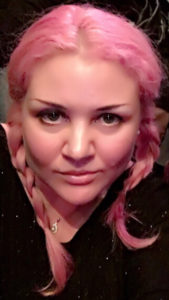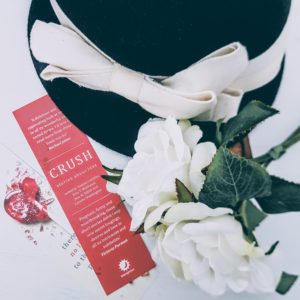Next up in our series of Q&As with the authors of Crush is Michele Fairbairn. Read on to get to know her and her writing process, and to see an excerpt from her story ‘Fettucancé’.

Can you give us a bit of background about yourself? How did you come to writing?
At the risk of sounding naff, it did not feel like I came to writing. Story is woven into the fabric of who I am. My first recollections as a child were feasting on stories oral and written, as well as the wordless stories that I could sense in the land I grew up on in the Barossa Valley. I have always felt the need to tell stories and had an intuitive sense of the transformative qualities of story in my work both in arts and health.
I crave and embrace adventure. Not the bungee jumping variety but the diving-without-safety-cord-into-learning-and-experience variety. As a result of this, I have studied and worked extensively in the health and arts sector including as a youth worker, counsellor, community health worker, art therapist, naturopath, remedial/manual therapist, transpersonal psychotherapist, playwright, performer, theatre devisor, visual artist and Psychology student.
How do you get your ideas? Is there anywhere in particular you look for inspiration?
I don’t consciously look for inspiration. Ideas tend to come in fits and starts – lightening-on-the-landscape moments that often begin to take shape and form at the most mundane, inopportune and impractical times. A word, a quote, a look, a musical note, a texture, a life event, a touch, a movie, the work of another writer or a dream (the ones that lay out an entire play – dialogue, scene, set design, music – bliss!) are some of the ways.
What does your writing process look like? Does it change from story to story?
My writing process has been known to cause some level of consternation to the publications, producers and the theatre folk I have worked with. There does, however, seem to be a pattern of sorts: (1) ferment/sit on story-eggs (a lot), doddle, doodle, (2) lighting-on-landscape moment, (3) write feverishly without care nor consideration for food, sleep, biological imperatives or editing and (4) deliver; and then back to (1) egg-sitting and fermenting.
This process doesn’t change from story to story. When I finally do get to the point of writing, it is quick and I rarely edit afterwards. It seems that the draft process takes place during fermentation before the writing even happens. It doesn’t change much from one medium or genre to another either.
Perhaps workshopping a theatre script has been one of the few times I have felt like I have conformed to an ideal around being disciplined as a writer. This involved workshopping a script-in-progress with a director and actors and then applying the notes/insights of the day to the script that evening only to repeat the process doggedly for anywhere from a week to a month or more (depending on funding). I enjoy this process. It is less isolating, more collaborative and tweaks my writer discipline muscle fibres.
How do you approach building the structure of a story? Do you like to play with form?
I have never mapped out a story or a play, or anything aside from my career direction. In truth, there is no real structure to my process. There is an idea, it arrives in full (normally) and I write it. It’s as simple and difficult as that! Sometimes a character or narrative will grow it’s own wings and fly off in an unexpected direction. My job is to follow it and keep up if I can.
I love to play with form. In fact, that is the foundation of my craft. Perhaps my training and work as a visual artist has contributed to this in some way or, potentially my interest in psychology, philosophy, sociology and human biology have created a desire to deconstruct, excavate and examine in depth how things exist, work, sit, look and feel – including words.
I like to play with words, tease them and coax them and harass them into making sense of the story I am trying to tell. I enjoy making up words and this doesn’t seem to be a thing I am cognizant of as it happens. Sometimes there is a blank space that can only be filled with a word that has been constructed in that moment. So I use it.
Crush explores a variety of interpretations and experiences of romantic love. What aspects of love did you want to explore in your writing?
First of all, I am fascinated with the notion of love. Romantic love seems to be riddled with juxtapositions. There are a flurry of different perceptions, incarnations and values attributed to eros.
Something of particular interest to me is the secret loneliness that seems to inhabit this love-space. The initial wave of external validation folks ride with dizzy rapture when chemistry and circumstance allow for eros to blossom inevitably evens out into a space which, if you dig a little beneath the top soil, conceals a subterranean loneliness – potentially even disappointment or confusion that another person can never fill the space that must be filled by ourselves.
I wanted to address some of the complexities that arise from intuiting and being at war with this and the mighty effort that must be applied to maintaining the illusion and status quo. The lengths that some will go to not to be alone that may inevitably lead to a state of disconnection from authentic self and others that may potentially culminate in an even deeper state of isolation and loneliness than what they were first attempting to avoid.

How have you tried to either embrace or push the boundaries of the romance genre in your writing?
I am not a romance writer and actually have no real working knowledge or point of reference in terms of this genre, so I haven’t attempted to do either.
By nature I tend to push boundaries and also, to be involved with movements, organisations, projects and subcultures that by merit of their existence and ideologies are considered boundary pushers, however, there was no conscious decision to do so when writing this piece. It, as with most of my writing and arts practice, was just about telling a story and playing with words.
What drew me to this project was that it invited a nuanced approach to the subject matter and I’m all about nuance, especially when it came to a theme with so much scope for the imagination.
Excerpt from ‘Fettucancé’ by Michelle Fairbairn
Two things of significance have taken place over the past two weeks.
They may or may not be related.
Number one—
My entire left hand side has become numb. Post-dental-visit numb. I can’t feel a prickle or the coolness of jelly, numb.
There is a line drawn precisely and intimately straight down the middle of me.
How very strange.
Number two—
Whilst draining fettuccine for our meal last Friday evening, I was asked for my hand in something resembling marriage.
It went as follows—
Her: Would you like to go shopping?
Me: Is it in the budget?
Her: For rings.
Me: That’s not in the budget.
Her: Engagement rings.
Me: (A sudden fascination with the ability of fettuccine to speed dry and grip to the edge of a colander.)
At the risk of sounding ungrateful when clearly all the world needs now is love sweet love…while straining fettuccine?
To read more of ‘Fettucancé’ by Michele Fairbairn, pick up a copy of Crush from our online shop or from all good bookstores.
